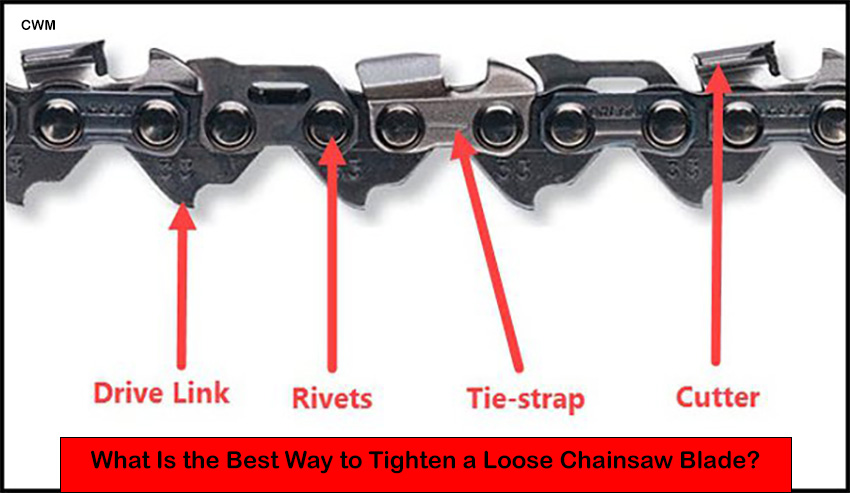The best way to get the most out of your homesteading chainsaw is to keep it in good operating condition at all times. Chainsaws are essential tools that do many duties on the farm and at home.
A chainsaw chain should be properly tensioned for efficiency and safety reasons. You will have no choice but to stop working in the middle of a task if a chainsaw chain snaps.
Table of Contents
How to Fix Chainsaw Chains Coming Off
Chainsaw chains fall off the bar as a result of worn-out bars, worn-out sprockets, and incorrectly adjusted tension. It’s also worth noting that chains lose tension with time and are thus more prone to fall off the bar when you least expect it. There are several methods for repairing slack chainsaw chains and restoring your chainsaw to stay productive.
While it is possible to mend loose chains in a few minutes and then return to sawing, it is important to note that this is not a long-term solution. So, what if the situation remains and the phrase “chains keep coming off” becomes the order of the day? If this is the case, we believe the issue with your saw is more serious than you may have believed, necessitating the need for a long-term remedy.
This article is for you if you are a homesteader, commercial woodworker, or forest service employees who frequently use chainsaws. While you can easily snap the chain back into line with the cutting chain, the fact that it continually falling off creates a more difficult scenario, especially for a newbie who is unfamiliar with this powerful equipment.
Jump in with us as we look at the reasons why a chainsaw chain keeps falling off and how to fix it. Most significantly, by the conclusion of this piece, you should be an adept DIYer, capable of repairing equipment such as chainsaws when problems such as slack chains become commonplace.
What is causing the chainsaw chain to come off?
Before we go any further, you may be be wondering what causes a chainsaw chain to fall off. You may alternatively reframe the question: What causes chainsaw chains to fly off the guiding bar? Well, this occurs for a variety of reasons. Specifically the following:
Chain Tension Incorrectly Set
You may have assumed that increased tension results in improved chainsaw performance, particularly while cutting firewood at full power. However, it turns out that over-tightening a chainsaw blade is not a good idea, nor is having it too loose to produce an excellent grip on the guiding bar. The catch here is that if your chainsaw chain continues falling off, you should examine the chain tension and ask yourself if it is appropriately or incorrectly adjusted.
Let us say that with the proper chain tension, the productivity and longevity of the bar, motor, and chain increase. It is also worth noting that if the chain has too much slack on it, it is likely to fall off. So, what’s the next step if that’s the case?
The Bar Rails Might Be In Bad Shape
The issue with chains that continually falling off does not end with poor chain tension, a worn-out drive sprocket, or a worn-out bar heel. Because the bar rails are in poor condition, there is a good probability that the chainsaw blade will continue to fall off. Let’s start by acknowledging that, of all the components of your chainsaw, the bar rails endure the most stress over its productive lifespan, especially while you’re out in the woods cutting. Working at full throttle, for example, puts the bar rail’s lifespan at risk since the chain rotates at a fast speed. There is always the possibility of unintentionally cutting into the earth.
A faulty bar rail means more trouble for your chainsaw. The most noticeable result is that the chain’s drive links will lose their precise hold on the guiding bar. As a result, chainsaw chains will frequently fall off the bar.
Based on the various causes of the chainsaw blade slipping off, you should deal with the problem before continuing to cut wood. It is also worth noting that there are several additional reasons of the condition. They include a loose guide bar, insufficient chainsaw oil, and a disengaged adjustment.
What Is the Best Way to Tighten a Loose Chainsaw Blade?
With a loose chainsaw chain that keeps falling off, an even more urgent task arises. How do you tighten a slack chain? When changing tension, the dime (or similar coin) technique includes placing a dime between the bar and the chain.

But, before we go any further, keep in mind that as you use your chainsaw, the chains will definitely stretch and become loose after a while (especially new non pre stretched chains) . We’re sure you don’t want to be cutting wood with a sloppy loose chain since it will undoubtedly end in disaster for you. Check the tension of the chain on a regular basis to see whether it needs to be repaired.
Most essential, keep in mind that you cannot create the perfect solution if you do not understand proper chainsaw chain tension. If you are unfamiliar with this critical part of your saw, you may wind up with a chain that is too tight or too loose to perform anything. At this point, let’s go into chain tension and what a proper one looks like.
Inadequate Chainsaw Chain Tension
You can tell if a chain is loose by pulling it away from the guide bar. A chain that readily slips off the bar requires immediate tightening. You should also look through the drive links. If they are not engaged, it is time to adjust the chain tension.
Optimal Chainsaw Chain Tension
Pull the chain and take notice of the drive links if the tension is good or proper. Everything is in place and ready to saw if the drive links are intact. In layman’s terms, when you remove the chain from the guiding bar and detect a very slight space in between, everything is OK. However, you should keep in mind that the separation should not be too large, as this would indicate inappropriate tension. Even if you run your chainsaw at full speed, chains that are too tight to move will not tear wood properly. The risk of the chain breaking is always present as well as wearing out the chain sprocket.

